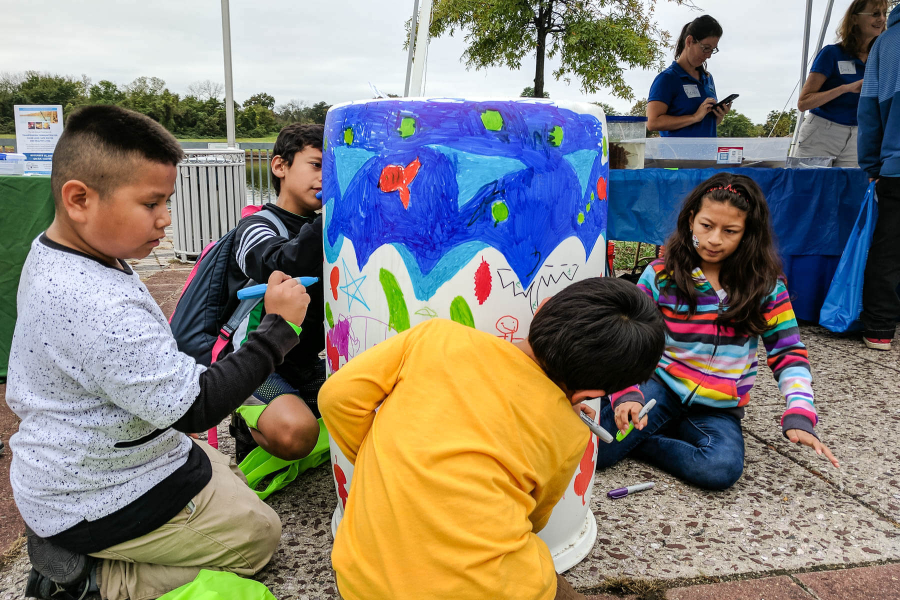Watershed leaders call for environmental education for all
Diversity, equity and inclusion major theme at biennial environmental literacy summit

Environmental education experts, cabinet level representatives for state government and other decision-makers from throughout the Chesapeake Bay watershed gathered at the Potomac Science Center at George Mason University to highlight challenges to and explore possible solutions for ensuring environmental education resources and opportunities are distributed equitably among all students.
These biennial summits provide the opportunity for state secretaries of education and natural resources from throughout the entire watershed to come together and collaborate on ways to advance environmental literacy.
"Understanding the environment is every bit as important to a child's education as any other subject because it underpins life on planet earth, including our economy," said Matthew J. Strickler, secretary of natural resources for the Commonwealth of Virginia. "To protect treasures like the Chesapeake Bay, we must teach people their connection to them as well as their true value and ensure that every child from every background has meaningful environmental education and experiences."
Under the Chesapeake Bay Watershed Agreement, Delaware, Maryland, Pennsylvania, Virginia and the District of Columbia committed to help their students graduate with the knowledge and skills needed to protect and restore their local watersheds. The Chesapeake Bay Program uses its Environmental Literacy Indicator Tool, a voluntary survey, to track progress toward meeting environmental education goals. The last survey was distributed in 2017 and was completed by 132 school districts in Maryland, Pennsylvania, Virginia and the District of Columbia, representing 75 percent of the public-school students in the watershed.
Since the signing of the Watershed Agreement in 2014, school districts located in the above-referenced areas have reported a slight rise in their preparedness to put environmental education programs in place, as well as an increase in the number of schools that are operating sustainably and a steady level of curriculum-embedded opportunities for students to learn outside.
The Watershed Agreement also adopted for the first time a goal to increase the number and diversity of people who support and carry out conservation and restoration work. By expanding access to the natural world and helping schools reduce their impact on the environment around them, the 2.7 million students in the Chesapeake Bay watershed will learn to play an active role in environmental protection, nurture their sense of stewardship and benefit from a positive impact on their health.
In 2018, the Chesapeake Bay Program’s Principals’ Staff Committee committed to biennially convening high-level leaders in both education and the environment to discuss progress toward the partnership’s environmental education goals. In August 2018, Chesapeake Executive Council Chair and Maryland Governor Larry Hogan called on his fellow watershed states to use the data and information collected by the Chesapeake Bay Program to develop strategies to equitably direct their resources toward ensuring all students have access to outdoor learning experiences and a sustainable school environment. Virginia Governor Ralph Northam, a Chesapeake Executive Council member, requested that his home state host the 2019 summit.
The 2019 summit featured voices from non-governmental organizations that are working to increase environmental literacy access to all students. They discussed addressing inequities in our education system and strategies for how to increase diversity in the broader environmental movement.
“At the National Aquarium, we work diligently to foster authentic and lasting involvement of our neighbors and core audiences in our conservation initiatives, developing and conducting our environmental education, community engagement and conservation programs through the lens of diversity, equity, inclusion and justice,” said Curtis Bennett, director of equity and community engagement at the National Aquarium. “We sincerely value and appreciate the opportunity to be part of events and conversations like this one, through which we can create a safe, inclusive space to have an open dialogue about our processes, programs and initiatives, while re-envisioning what success looks like and ultimately, how we can get there together. If we are intentional and steadfast in our pursuit of equity and inclusion in conservation, opportunity is boundless and now is the time to act!”
Learn more about environmental literacy.

Comments
There are no comments.
Thank you!
Your comment has been received. Before it can be published, the comment will be reviewed by our team to ensure it adheres with our rules of engagement.
Back to recent stories